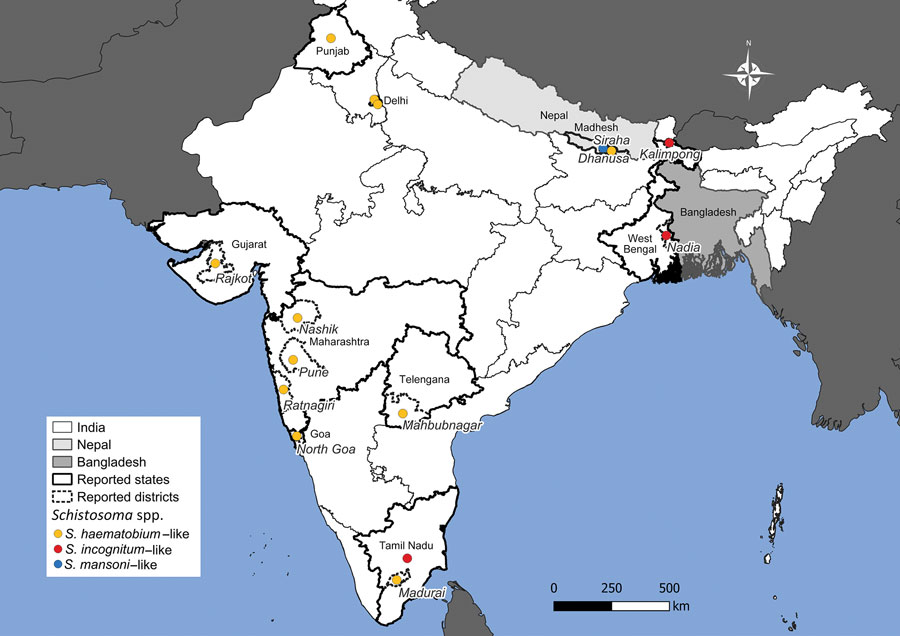Volume 30, Number 6—June 2024
Dispatch
Human Passage of Schistosoma incognitum, Tamil Nadu, India, and Review of Autochthonous Schistosomiasis, South Asia
Figure 2

Figure 2. Geographic locations of Schistosoma incognitum passage from humans and autochthonous human schistosomiasis in India and Nepal. Map shows credible reports of urinary or fecal passage of schistosome eggs in India and Nepal from this study and others (1,8–11,14,15). Included patients had no reported travel history to known endemic areas. Where possible, state and district information are provided.
References
- Chandler AC. A new schistosome infection of man, with notes on other human fluke infections in India. Indian J Med Res. 1926;14:179–83.
- Sinha PK, Srivastava HD. Studies on Schistosoma incognitum Chandler, 1926. I. On the synonymy and morphology of the blood-fluke. Parasitology. 1956;46:91–100. DOIPubMedGoogle Scholar
- Ajjampur SSR, Kaliappan SP, Halliday KE, Palanisamy G, Farzana J, Manuel M, et al. Epidemiology of soil transmitted helminths and risk analysis of hookworm infections in the community: Results from the DeWorm3 Trial in southern India. PLoS Negl Trop Dis. 2021;15:
e0009338 . DOIPubMedGoogle Scholar - Agrawal MC. The schistosomes. In: Agrawal MC editor. Schistosomes and schistosomiasis in South Asia. New Delhi: Springer India; 2012. p. 7–50.
- Carney WP, Brown RJ, Van Peenen PF, Purnomo , Ibrahim B, Koesharjono CR. Schistosoma incognitum from Cikurai, West Java, Indonesia. Int J Parasitol. 1977;7:361–6. DOIPubMedGoogle Scholar
- Dutt SC. On the susceptibility of Macaca mulatta to infection with Schistosoma incognitum. Curr Sci. 1965;34:49–51.
- Das M, Agrawal MC. Experimental infection of rhesus monkeys with Schistosoma incognitum and Orientobilharzia dattai. Vet Parasitol. 1986;22:151–5. DOIPubMedGoogle Scholar
- Gadgil RK, Shah SN. Human schistosomiasis in India. Discovery of an endemic focus in the Bombay State. Indian J Med Sci. 1952;6:760–3.
- Dhanda L. Infestation with ova morphologically resembling Schistosoma haematobium. J Indian Med Assoc. 1956;26:407–8.PubMedGoogle Scholar
- Santhanakrishnan G, Sundarajajulu G. Human schistosemiasis in India: discovery of an endemic focus in the Madras State. Curr Sci. 1967;36:480–1.
- Bidinger PD, Crompton DW. A possible focus of schistosomiasis in Andhra Pradesh, India. Trans R Soc Trop Med Hyg. 1989;83:526. DOIPubMedGoogle Scholar
- Kali A. Schistosome infections: an Indian perspective. J Clin Diagn Res. 2015;9:DE01–04.PubMedGoogle Scholar
- Shrivastava KK, Arora MM. Schistosoma haematobium infection in Lahager, a village in Raipur District of Madhya Pradesh. Indian J Med Res. 1969;57:2016–7.PubMedGoogle Scholar
- Sherchand JB, Ohara H, Sherchand S, Matsuda H. The suspected existence of Schistosoma mansoni in Dhanusha district, southern Nepal. Ann Trop Med Parasitol. 1999;93:273–8. DOIPubMedGoogle Scholar
- Sah R, Utzinger J, Neumayr A. Urogenital schistosomiasis in fisherman, Nepal, 2019. Emerg Infect Dis. 2020;26:1607–9. DOIPubMedGoogle Scholar
Page created: May 02, 2024
Page updated: May 22, 2024
Page reviewed: May 22, 2024
The conclusions, findings, and opinions expressed by authors contributing to this journal do not necessarily reflect the official position of the U.S. Department of Health and Human Services, the Public Health Service, the Centers for Disease Control and Prevention, or the authors' affiliated institutions. Use of trade names is for identification only and does not imply endorsement by any of the groups named above.